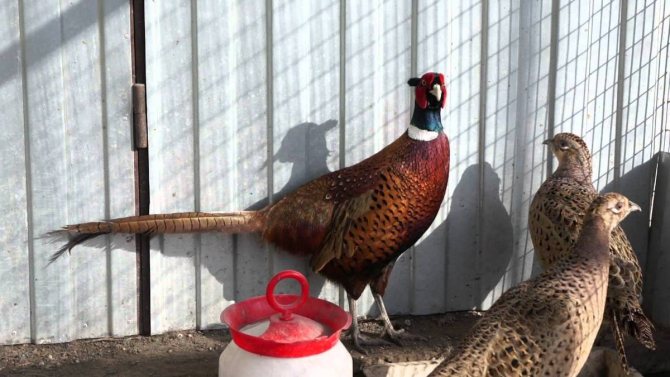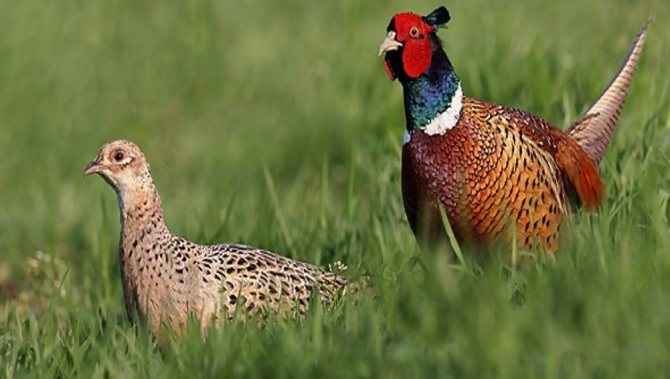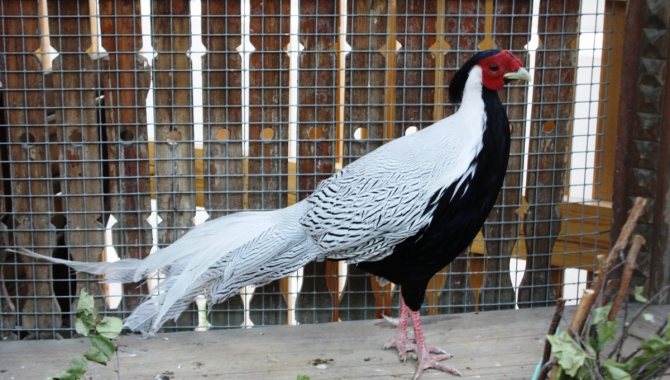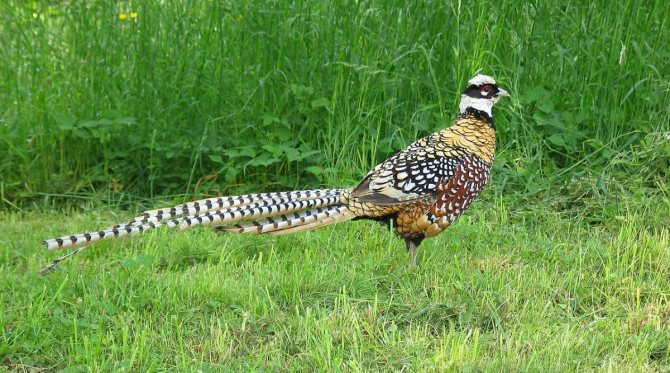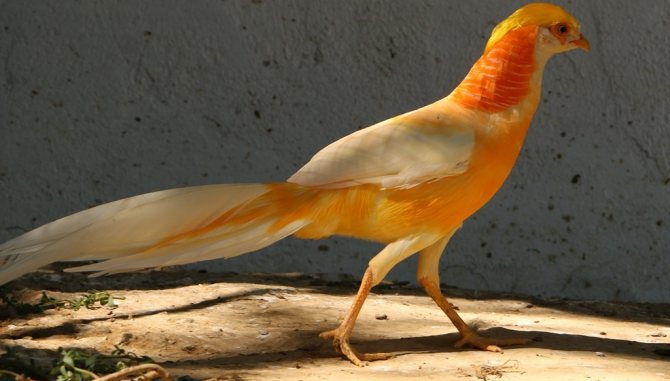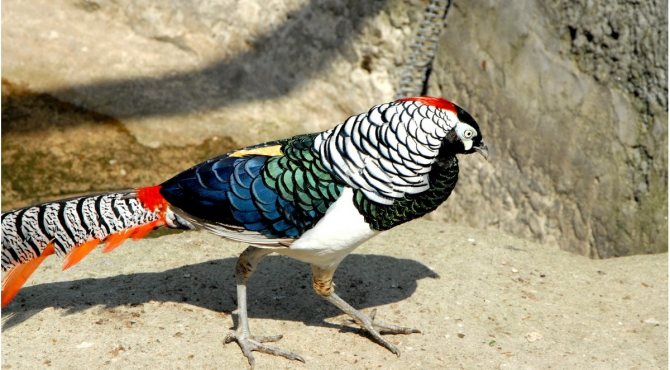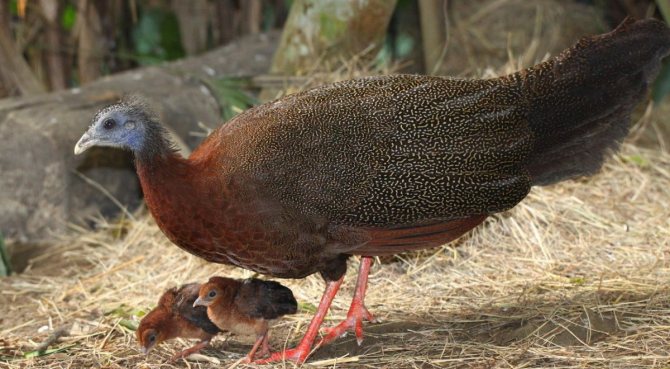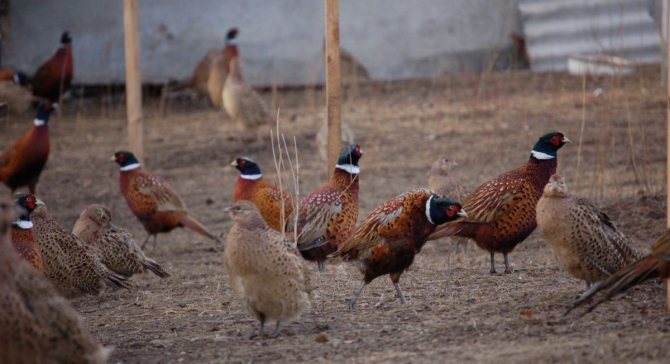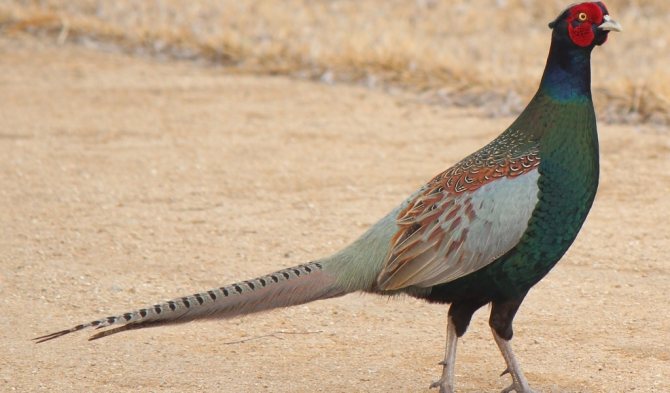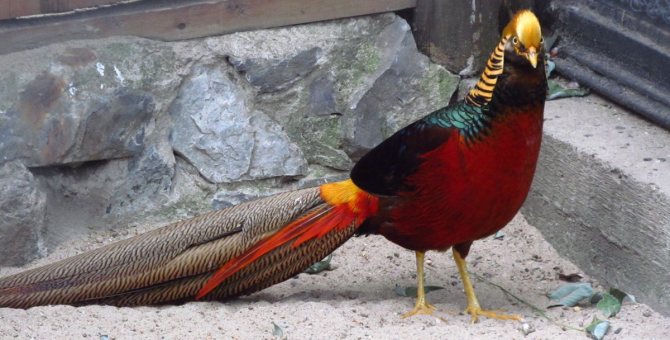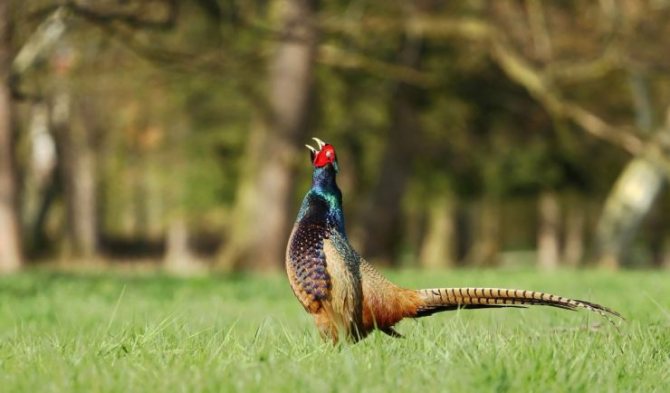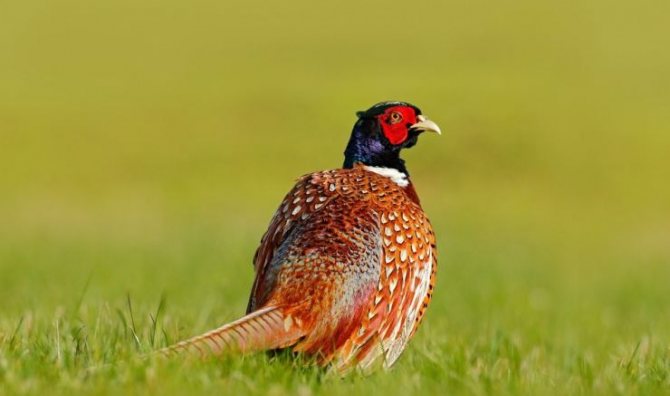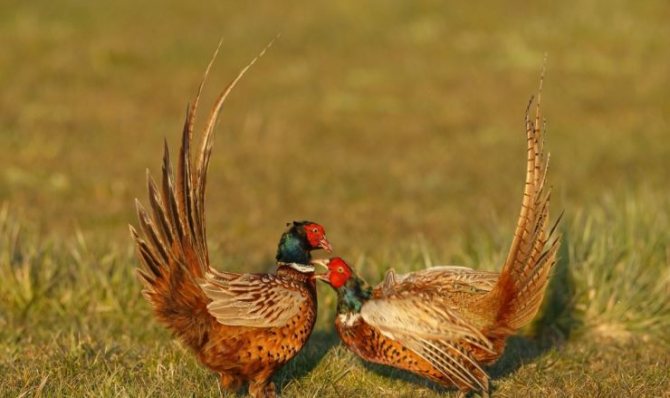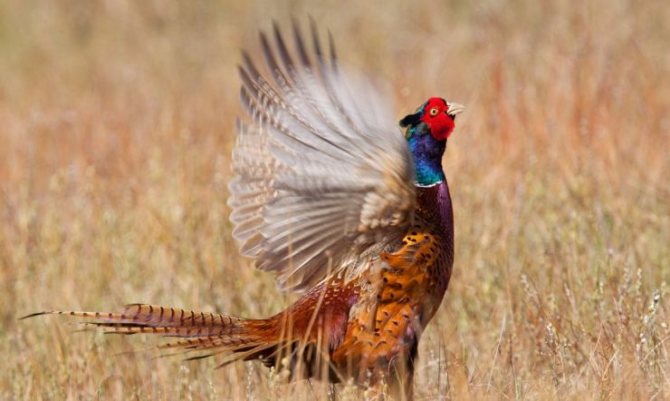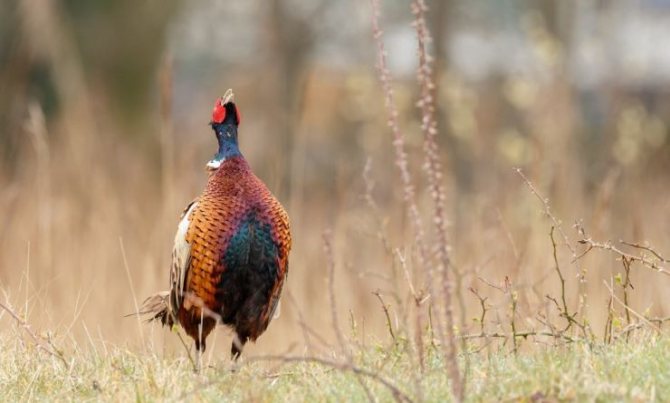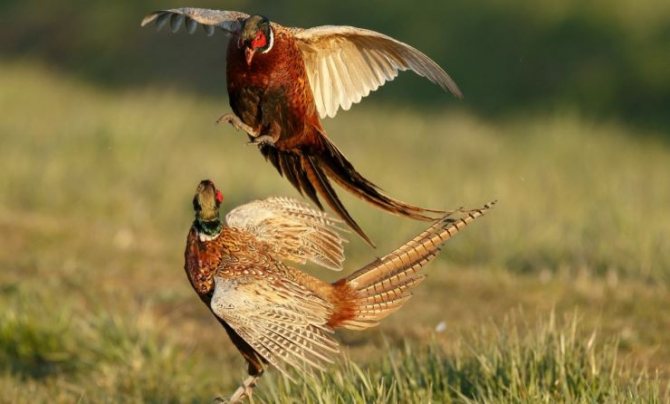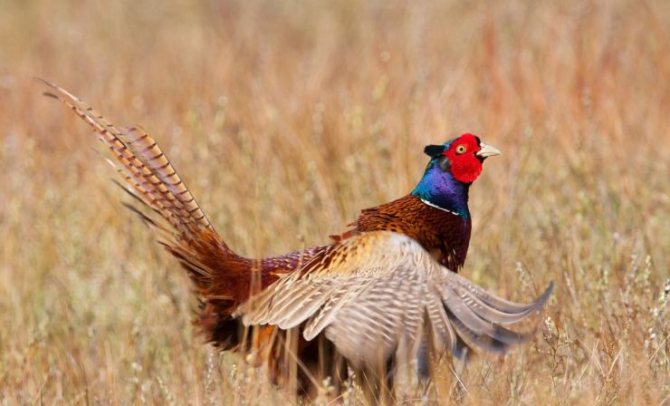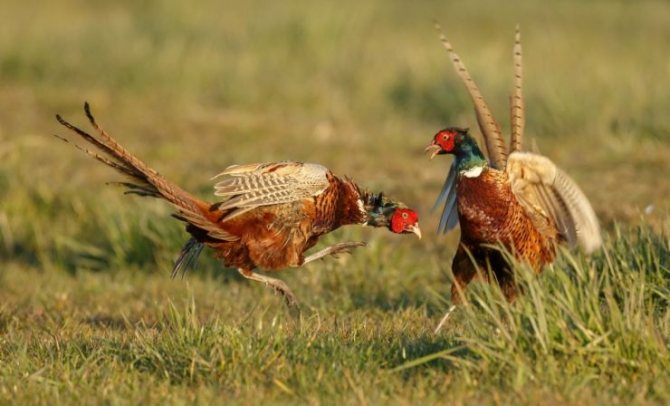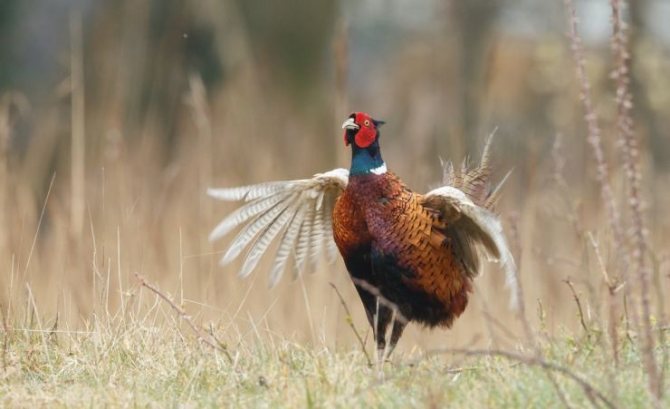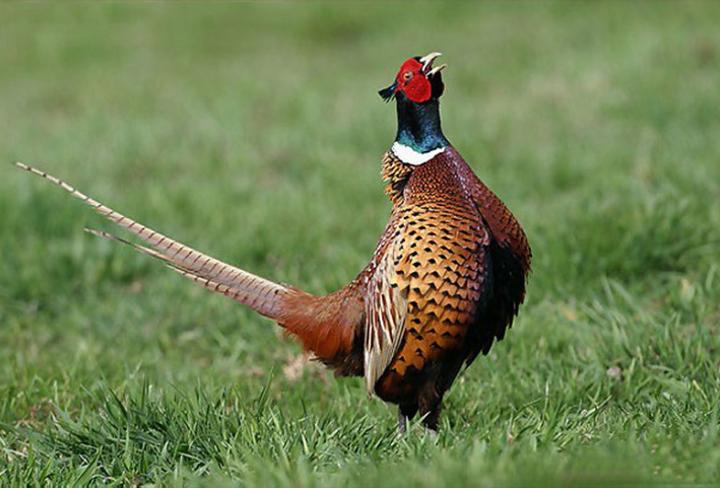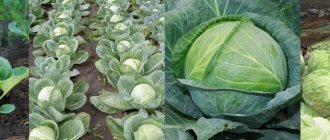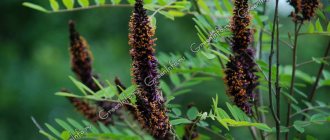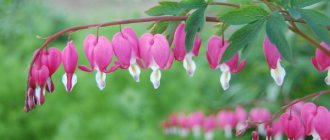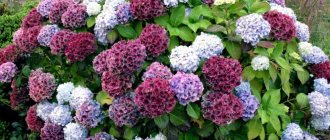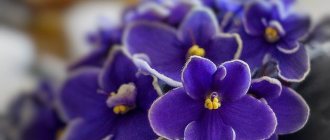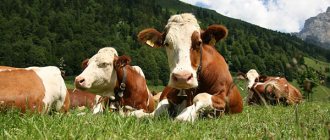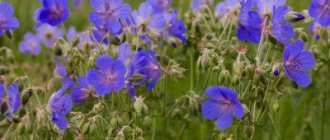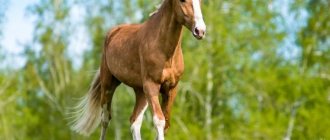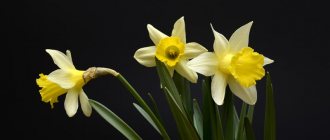Pheasant - This is a domesticated feathered member of the group of chickens. These Eurasian birds are popular in the household and are often raised for hunting purposes. The bird is very attractive in appearance and has bright plumage. The meat is considered dietary and is considered a delicacy in the world market. A pheasant in its natural environment is an extremely shy animal. He loves to live in solitude, so it is difficult to get a photo of a pheasant, because he rarely appears in front of the camera lens.
Common pheasant
These birds are very similar in appearance to chickens, but their tail is much longer.
The bird weighs 0.7 - 1.7 kg. The plumage is very bright colors - on one bird you can see feathers of orange, and purple, and dark green, and golden colors. But the tail of most common pheasants is the same - yellow-brown in color with a copper-purple tint.
Pheasants are smaller than pheasants in weight, their feather color is poorer. The body length of the male is 85 cm with a tail. Females are smaller.
In the wild, common pheasants live near water in an area where there is a lot of vegetation.
Most often, these birds can be found where reed grows, and fields with rice, cotton, corn or melons are located nearby.
These birds are very careful, their easy to scare off... They run very quickly, even through dense thickets.
Pheasants rarely climb trees, most of the time they live on the ground.
Their diet consists of weed seeds, insects. Therefore, pheasants are of great benefit to agriculture.
The aviary for them should be large and covered, because these birds are afraid of drafts, but they are not afraid of low temperatures.
The ground in the aviary should be covered with material such as sand, straw or sawdust. You can let pheasants go for a walk outside the enclosure, the birds will not go far. You need to keep them in pairs.
The nesting period begins in the last days of February - early March. The duration of this period is four months.
Females nest on the ground, build a nest from twigs and stems of plants. One clutch can contain from 7 to 18 eggs of brown-olive color with a green pearlescent tint.
Pheasants of this breed are very good mothers, will incubate eggs to the last, absent only to eat.
If eggs are taken immediately after laying, the female will lay more. Thus, for the entire nesting period, about 50 eggs can be obtained.
Eared pheasant
Eared pheasants are one of the most massive birds of this species.
There are 3 subspecies of this breed - pheasant blue, brown and white. The body of these birds is oblong, the legs are short, but powerful, with spurs.
Blue and brown pheasants have long white feathers near their ears, which rise upward. Hence the name of the breed, as these feathers form a kind of "ears".
The feathers on the head are colored shiny black, and the circles around the eyes and cheeks are bright red. The feathers of both the male and the female have approximately the same plumage color.
Eared pheasants can be found in the wild in the mountains of East Asia, but birds of different subspecies do not overlap. Pheasants of this breed form large flocks throughout the entire time, except for the breeding period. But even in this, the female and the male try to stick together.
These pheasants get food from the ground with their paws and beak, and their diet consists of green plants and insects.
The brown pheasant is so named because of the color of the plumage - it has a brown color. In the area of the back, feathers have a weak blue-green tint, and in the tail area, feathers can be cast in gray shades. The beak is yellow with a reddish tip.
Males have small spurs on their legs. The legs themselves are red. Males can grow up to 100 cm in length, while the tail takes more than half of this length (54 cm). Females of this subspecies are smaller than males.
The blue pheasant has a blue plumage with a slight ash-gray sheen. The head is painted black and the chin and neckline are white. The wing feathers are dark brown, but the tail feathers can be stained in a wide variety of colors. The beak is dark brown, the legs are red.
Males reach 96 cm in length, of which 53 cm goes to the tail. The female is smaller than the male.
The white pheasant is almost entirely white, but the top of the head is black and the area around the eyes is red. The tips of the wings are brown, and on the tail, the red and brown shades are mixed.
You need to keep eared pheasants in the same way as ordinary pheasants.
Eared pheasants have a poorly developed maternal instinct, therefore, to hatch pheasants, you need to place eggs either in an incubator, or under a turkey or chicken.
With the incubation method of introducing young eared pheasants, the humidity in the incubator must be made lower than for hatching young pheasants of the common breed.
Horned (tragopan)
The main difference between tragopan is the processes near the eyes, which are shaped like cones. The color of males is bright, with predominant red and brown colors. The neck is decorated with "earrings" made of small growths. Birds are large breeds. Sexually mature males can weigh up to 2.2 kg. Fazanihi of a discreet color of brown shades. They also lack cone-shaped appendages on the head and “decorations” on the neck. They are half the size of males, weighing only 1.3 kg.
The tragopana species has five subspecies:
- Blackhead (western). Black short feathers on the top of the bird's head form a kind of cap. There is also a small scarlet crest on the head. The "mask" around the eyes is leathery, bright red.
- Cabot (brown-bellied). It has a dark feather "cap" and an orange tuft.
- Blyta (gray-bellied). The long feathers on the head are also orange, but with a charcoal stripe. Refers to large representatives of the species.
- Temminck (ocellated). The most decorative subspecies. The crest consists of long feathers of charcoal and orange shades. The “horns” are blue, the leathery “mask” is the same color. The growths on the neck are blue with a turquoise tint.
- Satyr (Indian). The feathers on the head form a black crest covered with bright red spots.
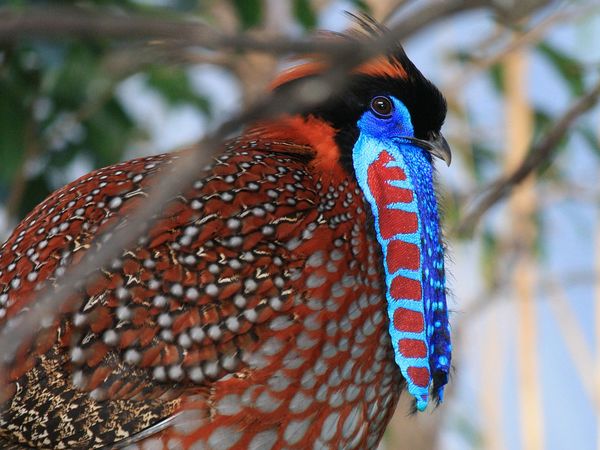
The main difference between tragopan is the processes near the eyes.
Hunting pheasant
This bird is a hybrid. It was bred by crossing several subspecies of the common pheasant.
Those hunting pheasants that live in Europe were obtained by crossing the Chinese and Transcaucasian subspecies.
The length of the hunting pheasant reaches 85 cm, and in weight it gains 1.7 - 2 kg. Males have a very bright appearance., their tail is long and pointed at the end.
The legs are very strong with spurs. In color, the hunting pheasant hardly differs from the ordinary one, but not so long ago birds were bred, the plumage of which is completely black. Females are sandy-brown in color, and they are smaller in size than males.
Under the conditions of home breeding, hunting pheasants live semi-monogamously, that is, there are 3-4 females per male. Sometimes males fight for the female.
You need to keep these birds in an aviary.and “families” to minimize the likelihood of conflicts between birds.The diet of pheasants should be mainly vegetable.
If you let the birds go for a walk outside the enclosure, then they themselves will find their own food in the form of insects. It is better to hang greens on the side lattice of the aviary.
Hunting pheasant meat has a special value due to its excellent taste and dietary qualities.
The taste of the game is moderate. Cholesterol content in meat hunting pheasant enough low.
The egg production of this breed of pheasants is quite high. During the laying period, which lasts about 3 months, one pheasant can lay up to 60 eggs, and 85% of them will be fertilized.
It is better to hatch pheasants in incubators.
Some interesting information about pheasants
Ever heard the name pheasants are long-tailed hens? It would be a question of how one can compare the grace of a pheasant and the clumsiness of a chicken, but those who say so are absolutely right. The pheasant is a bird from the order of chickens and behaves very much like ordinary chickens. It got its name from the Phasis River, which flows past a settlement in Greece, where it was first tamed.
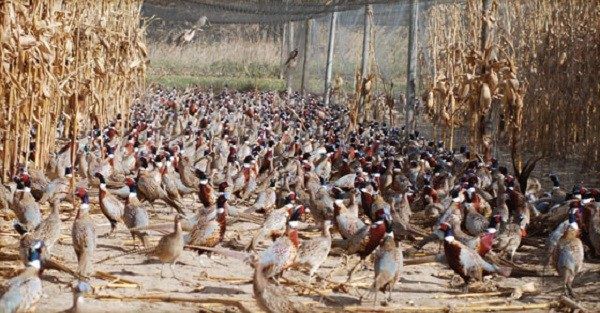

The pheasant is a cheerful bird, very attached to the feathered public of its kind
Under natural conditions, the pheasant lives in shrubs and tall grass. An adult bird can climb a tree, but prefers to move along the ground. The homeland of most breeds is China, its mountainous forest areas, in which pheasants can climb to incredible heights above sea level - up to 4000 meters. There they feel great, living, as a rule, near reservoirs in dense thickets of reeds, bushes, ferns or bamboo.
The nature of birds, as a rule, is cheerful, not aggressive towards people and comrades. They gain weight very well. The meat of the slaughtered bird is dark, with a low fat content. Its taste attracts many gourmets around the world.
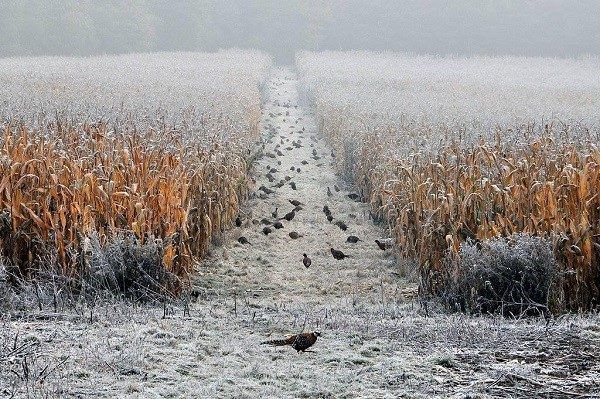

Pheasants wait for cold snaps and go to the fields cultivated by man to collect the remnants of suitable food there.
You can use not only pheasant meat product, but also its feathers. According to the beliefs of many countries, the feathers of this amazing bird bring happiness to their owner. That is why earrings, necklaces and other jewelry made from pheasant feathers are often found in the markets. Pheasant eggs are not consumed. They are certainly edible, but too valuable to be eaten in the form of ordinary scrambled eggs, because the price of one pheasant is quite high not only as a carcass, but also as a living creature.
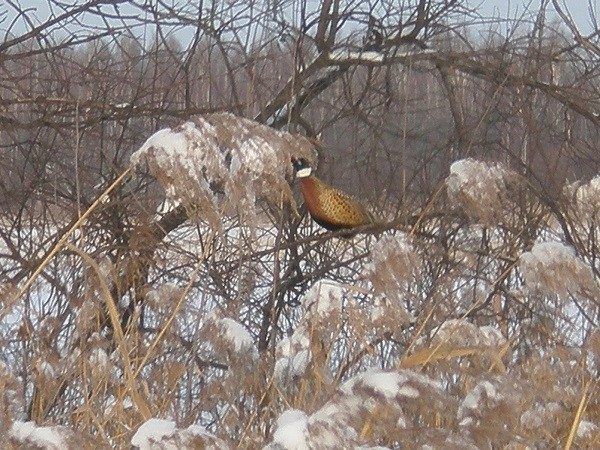

If there is no better shelter nearby, pheasants can sleep on tree branches, but prefer to move on the ground.
Some of the breeds listed in the article breed and lead a polygamous lifestyle, and some are monogamous. It is very important to take this into account when raising and settling birds, since in one enclosure there may be a male and two aggressive females who do not recognize polygamous relationships. They will fight, and the strongest will kill the weaker one. As a result, you will not get a big profit, but on the contrary, you will incur losses.
Diamond pheasant
The diamond pheasant was bred in the first half of the 19th century. Lady Amherst's pheasant and the diamond pheasant are one and the same bird.
This breed pheasants very beautiful... The back, craw and throat of males are colored dark green, the crest has a bright red hue, the hood is white with black horizontal stripes, the tail is black, the wings are green, and the abdomen is white.
The female has a shorter tail than the male, the color of the plumage is also less bright, but the stripes and spots are more clearly visible.
The female diamond pheasant has gray-blue circles near the eyes. The male grows up to 150 cm long with a tail 100 cm long.
The female is 67 cm long, and their tail is short - 35 cm.
The weight of an adult pheasant varies between 900 and 1300 g. Females are smaller, but not much. Oviposition begins already at the age of six months, we take a pheasant for the season can produce up to 30 eggs.
These pheasants are very peaceful, calm, they go to the hands of a person.They feel very comfortable in a closed enclosure.
Royal view
This is the largest species of ornamental birds that poultry farmers like to breed at home. The royal pheasant lives in the highlands in northern China. It is characterized by a yellow-brown plumage, a black rim around the neck and light feathers on the crown. The female is colored more calmly, her light brown and golden yellow feathers are diluted with dark blotches. The royal pheasant, in addition to its beauty, has a luxurious tail more than a meter long. In European countries, the royal pheasant is bred as a hunting bird, when in our country it can only be found in zoos.
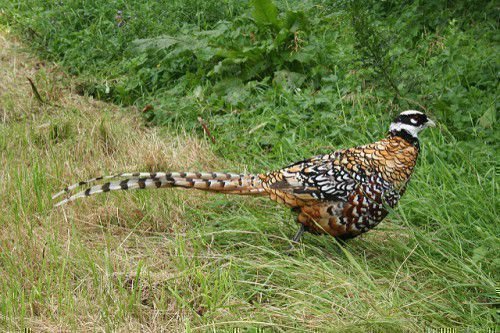

The royal pheasant has a tail up to 1 meter long
Golden pheasant
Birds of this breed are very beautiful, which is why they are popular among zootechnicians not only as a source of meat, but also used for decorative purposes. A golden pheasant was bred in the highlands of China. The male weighs no more than 1.4 kg, and the female - no more than 1.2 kg.
Males have a tuft of golden feathers on their heads, on which there is an orange rim and a black border. The back and upper tail are golden, and the abdomen is deep red. The tail is very long and black. Females do not have a crest, their feathers are gray-brown.
During the season, the average egg production is 40 - 45 eggs per adult female, young pheasants produce no more than 20 eggs. If eggs are taken from time to time, then the egg production rate increases by 35%.
The meat of golden pheasants is dietary, has an excellent taste, therefore it is widely used for gastronomic purposes.
Golden pheasants are not afraid of frosts with temperatures down to -35 ̊C, that is, they will feel comfortable in winter, living in a room that is not heated.
It is boring to keep them just like laying hens. The diet consists of leaves, herbs and small grains.
Due to their low immunity, golden pheasants are susceptible to various diseases.
Therefore, periodically these birds need to give antibiotics a broad spectrum of action.
How to collect pheasant eggs correctly
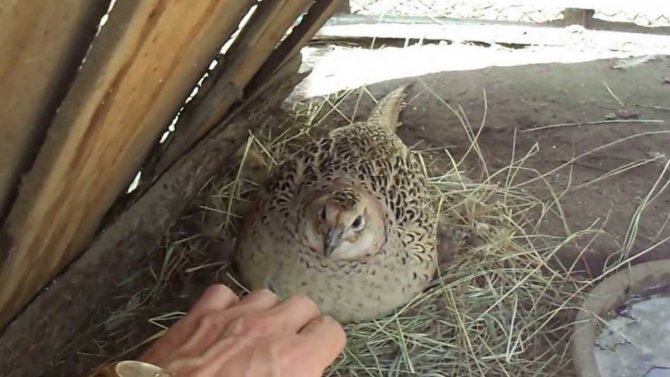

There is no need to disturb the female sitting in the nest.
The purpose of breeding pheasants is not only to obtain dietary meat, but also eggs. However, these products must be removed from the nests on time, observing the following rules:
- collecting eggs in the morning or afternoon, while the birds are eating;
- wash your hands thoroughly before collecting so that germs do not get inside;
- store products at temperatures from 5 to 12 degrees, in dark places with air humidity not higher than 70%;
- if the eggs are very dirty, you should not rub them with a rag, it is better to rinse in a weak solution of potassium permanganate.
Compliance with these rules is necessary in order for the products to be well preserved. If the collection is not made for sale or consumption, then you should know that in addition to keeping pheasant eggs in the incubator, turkeys or ornamental chickens can hatch.
Romanian pheasant
The Romanian pheasant is a subspecies of the common pheasant. Sometimes these birds are also called Emerald or Green.
The Romanian pheasant is a cross between the Japanese wild pheasant and the European breed of this bird. These birds got their name because of the characteristic emerald hue of the feathers. But they are not pure emerald - on the feathers you can see the tint of yellow, blue and other shades.
Romanian pheasants bred purposefully for meat, since these birds in weight can reach 2.4 - 2.8 kg. On industrial poultry farms, these birds are slaughtered at the moment when they reach the age of 6 weeks, that is, their weight will exceed 900 - 1000 g.
Egg production for the nesting period is approximately equal to 18 - 60 eggs, it all depends on the age of the pheasant.
The meat of Romanian pheasants is highly valued for its taste and dietary qualities.
In terms of content, this breed of pheasants does not differ from ordinary pheasants.
Clinoch tenebrosus
Wedge-tailed pheasants have one special feature - a split upright crest on the head. Also, males and females lack leathery rims around the eyes. Instead, the area is covered in a charcoal fluff. The color of the body is predominantly brown, variegated.
The wings are white or light gray with a dark pattern in the form of small stripes. The beak is black, the legs are sandy with pronounced spurs. Females do not differ from males in size. Their length is 65 cm, a third of which is the tail.
Breeding pheasants is an interesting and profitable activity. Many farms raise birds for slaughter or for sale to collectors. It is enough to know the characteristics of different breeds, as well as the conditions of their maintenance, so that the painstaking procedure justifies the efforts invested.
Silver pheasant
The silver pheasant is one of the most famous representatives of the broad-tailed pheasant. These birds are semi-wild, as they practically do not go to the hands.
These birds are bred not only for decorative purposes, but also for obtaining meat with a low fat content.
The male grows in length up to 80 cm without a tail, and with a tail - up to 120 cm. The pheasant can gain up to 4 kg of live weight. Females are much smaller than males, in length and weight they are almost 2 times inferior to males.
The males have a very characteristic color - they have black crests, chin and neck. The rest of the body is either gray or white with black stripes. The central tail feathers are white.
There is a red "mask" on the head. Females do not match the name at all. Their main color is olive brown. There are stripes on the belly, and they are different for each pheasant. The beak of the birds of this breed is gray, and the legs are red.
Egg production at silver pheasants very good - You can get up to 40 eggs per season. These birds have excellent immunity against various diseases.
They are also not afraid of low temperatures and wind, since their plumage is very dense.
These pheasants do not need special care. The feed for the bottom will be feed for chickens and geese. Also, they do not need a reservoir near the aviary.
It is quite difficult to breed and keep pheasants if you do not know the main subtleties of this issue.
But if you carefully study this issue, then no difficulties will arise, and after a while you will look at the little pheasants and be moved. Good luck.
Home content
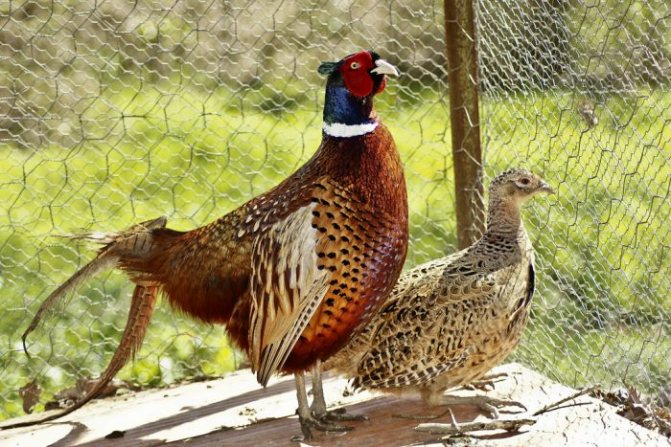

The first condition for keeping pheasants is sufficient space. For birds, an aviary or poultry house is suitable, in which there will be at least 2 m2 of area for each individual. A standard pheasant family consists of one male and a maximum of 10 females. Based on the number of individuals, the area required for the birds is calculated.
Since pheasants are not afraid of frost and cold weather, they can be kept in open enclosures all year round - in an area fenced with a fine mesh. At the same time, the bird loves dryness and does not tolerate precipitation well, therefore, shelters made of waterproof materials (slate, film, etc.) should be provided in an open aviary.
For the winter, the aviary is lined with straw.
Pheasants are also kept in closed poultry houses, but birds still need a fenced area for walking.
Common pheasant
The common pheasant is exactly the bird that was once hunted in the forests. Later, the bird was domesticated to decorate the royal courts and supply valuable meat to the table. The homeland of this breed is the Caucasus, they also lived in Turkmenistan and Kyrgyzstan. Today this breed is actively chosen by farmers for breeding for meat.
Description. In appearance, the bird looks like ordinary chickens. But there are also striking differences - firstly, the long tail feathers, tapering towards the ends. Secondly - the presence of red skin near the eyes - a facial "mask". Pheasant males always look brighter than females. The silvery-gray plumage of males has a lot of eye-catching shades - yellow, orange, purple, piercing green. On the neck and head are turquoise feathers.Females have only three main colors in plumage - gray, black and light brown. The legs of the males are equipped with spurs. The tail of males reaches 55 cm in length, the tail of females is 30 cm.
Productivity. The weight of the male is 1.8-2 kg, the weight of the female is up to 1.5 kg. Body length - 80 and 60 cm, respectively. The female lays about 50 eggs during the mating period. 1-2 pieces per day. Oviposition usually lasts from April to mid-June.
Other features. In nature, they settle in areas where there are shrubs, tall grass, ponds, fields with corn or wheat. Males are aggressive towards rivals - they arrange fights that can end in death. Females lay 8-15 eggs. The laying is done in a hole dug in the ground. The female incubates eggs herself for 3-4 weeks. Chicks grow up to about 5 months.
Maintenance and care. It is this breed that is more common in hunting farms than others. In nature, the bird eats berries and insects. When artificially kept in food, they are unpretentious. The main condition for keeping, as for any breed of pheasants, is a large indoor aviary. Pheasants tolerate frost well, but not drafts. They contain birds in pairs. The floor is covered with sawdust or straw bedding.
Mirrored or peacock
This subspecies consists of several breeds that share a common resemblance to peacocks. The second name for mirror pheasants is mountain pheasants. The area is limited to India, where they are grown for ornamental purposes. The plumage of adult pheasants is dark, almost charcoal, with a shining blue tint. Sometimes there is a silvery or pearl shade. The color of the loose tail strongly resembles a peacock.
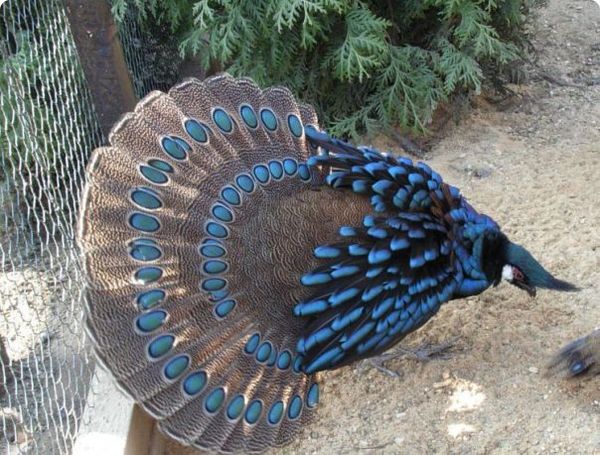

Mirror or peacock pheasant
There are 16 tail feathers, and they all participate in flight. A mature male can gain up to 2 kg of weight, while a female weighs 300-500 g less.
Hunting
The hunting breed was obtained by crossing green and common pheasants. The population is small. After crossing the hybrid, a variety of subspecies appear. Today, the hunting pheasant is found in the United States and Europe.
Description. The coloration is varied - from pure white to black. Males are traditionally more luxurious than females. The plumage casts green or lilac. The color is dominated by brown, orange, burgundy and bronze shades. Males have a red "mask", a black cap and a snow-white collar. The legs are powerful, decorated with spurs.
Productivity. The average weight of the female is 1.5 kg, that of the male is 2 kg. The body length is 80 cm, but of which 50 cm is the length of the tail. Females are distinguished by high egg production - in three months they can lay up to 60 eggs.
Other features. Differs in fertility and excellent health. Often used for breeding - to breed unique subspecies. The meat is tasty and dietary - low in cholesterol.
Males of a hunting pheasant are polygamous - they can live simultaneously with 3-4 females. They can conflict with other males, seeking the attention of the "lady" they like.
Maintenance and care. The bird is responsive to the nutritional value of the feed - it is worth increasing it, and weight gain immediately increases. They reproduce well and gain weight in artificial conditions. They are bred for slaughter, as well as for resale to hunting farms. The content of pheasants is almost the same as that of chickens. But during the mating period, it is better to separate the males from each other in order to avoid conflicts. Ideal conditions are a family of a male and six females. One pheasant needs 75 g of feed daily, and during nesting - 80 g.
Pheasants eating Colorado potato beetles in potato fields improves the flavor of the meat.
The origin and domestication of the bird
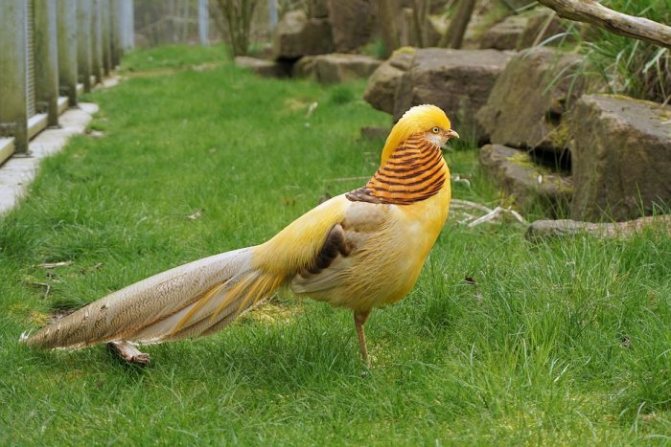

According to ancient legends, pheasants were brought to Greece by Argonauts from the ancient city of Phasis, an eastern settlement on the edge of Pontus. Today, the common pheasant is widespread and is found from Turkey to China and Vietnam.
Pheasants have been bred for hunting in Europe since the early 16th century.In the household, pheasants spread in the 19th century.
Diamond
This is one of the most beautiful birds in the world. The second name of the diamond pheasant is Lady Amkhrest, received in honor of the wife of the Governor-General, who sent the bird to London from India. From there, the diamond pheasant spread throughout Europe.
Description. The pheasant was called Diamond for a reason, its plumage shimmers like a precious stone. On the head are wide white feathers, similar to an old wig. Chest - olive or emerald, turns into a white belly. The goiter has a combination of white and black feathers. On the back - bluish-black plumage. The tail of the bird is especially luxurious. Females look traditionally modest - brownish-variegated plumage, around the eyes - bluish skin.
Productivity. The average weight of a male is 0.9-1.3 kg. Female - 0.8 kg. In clutch - 7-10 and more eggs. The female is capable of laying up to 30 eggs per season.
Other features. Birds are highly adaptive. They can get along with other types of birds - chickens, pigeons, etc. They are distinguished by a calm, peaceful disposition, are not shy, they easily make contact with a person. Diamond pheasant meat is dietary, very tender and tasty. Eggs are high in protein.
Maintenance and care. The bird, despite its exotic appearance, tolerates cold well and is not demanding on the conditions of detention. It is easy to breed it in private farmsteads. They are settled in spacious open-air cages in families, but one male - two females. The aviary should be divided into zones - for couples. To help birds gain weight faster, they are given fish oil. The rest of the diet is similar to chicken. Eats greens, grains, worms, vegetables and fruits. Bred for hunting, decorative purposes.
How to take care of young animals
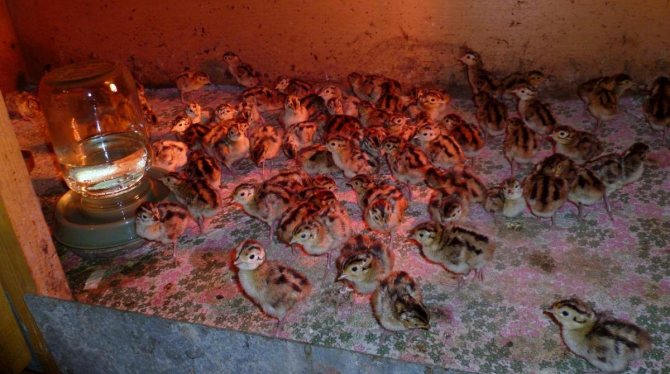

Pheasants need a high-protein feed for the first few weeks.
When breeding poultry, it is necessary to adhere to the rules for caring for young animals. The principles are as follows:
- providing space in the aviary, for 30 chicks there should be at least 1 sq.m. space;
- maintaining a temperature of at least +28 degrees in the first 3 days and at least +20 in the following weeks;
- proper feeding of young animals (up to the age of 2 months, chicks should be given boiled eggs and chopped greens, and subsequently gradually transferred to adult food).
By the age of six months, pheasants are already suitable for slaughter or breeding.
Gold
This breed is distinguished by its special majesty and beauty of plumage. Bred for meat and for decorative purposes. The bird lives in Eastern Europe. She can be found in nature reserves, in other areas she is a rare guest. But the homeland of the Golden Pheasant is not Europe, but Southwest China and East Tibet.
Description. The main difference between the breed is a golden crest, along the edges of which there is a black outline. The belly is maroon. Females do not have a crest. In the feather color of males, yellow, orange, black, ocher and blue shades are combined. The neck is decorated with an orange collar with a dark border. The tail is long and luxurious. Females are smaller in size and more modest in plumage.
Productivity. Average weight - 1.3 kg. In clutch - 7-10 and more eggs. During the season, the female can lay up to 45 eggs, young ones - up to 20 eggs. The peculiarity of the golden pheasant is that if you immediately pick up the eggs, then the egg production increases.
Other features. Meat with excellent taste. The disadvantage is weak immunity.
Maintenance and care. Breeding is not particularly difficult. Since the bird is prone to diseases, it is recommended to give it antibiotics along with feed. Although golden pheasants have low immunity, they perfectly tolerate frosts - they can withstand temperatures up to minus 35 degrees without harm to health. This bird can be kept in unheated rooms. Find more information about golden pheasant and its cultivation here.
The golden pheasant has several interesting subspecies. They are found naturally, and breeders also have them:
- Red pheasant. It is a wild variety of the Golden Pheasant presented to breeders after the breeders' work.
- Bordeaux. It has a color similar to the Golden Pheasant, but instead of red feathers, it has burgundy. This species was the first to be bred from the domesticated red pheasant.
- Golden Ghiji. It got its name in honor of the Italian Gigi, who was engaged in its breeding. A distinctive feature of the species - the whole body is covered with yellow-green plumage.
- Cinnamon. This species was bred in the United States. It has gray feathers on its back instead of blue and green plumage.
ferma.expert
Argus
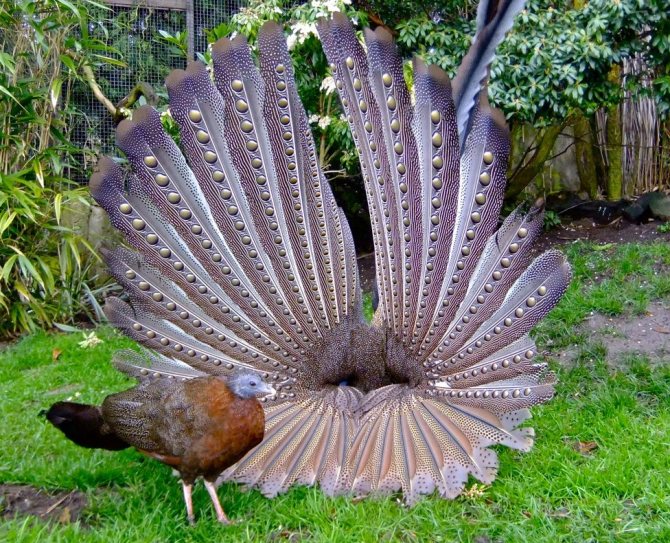

It is difficult to find ordinary words to describe the breed of pheasants called Argus. Representatives of this species have a head painted in bright blue, and a neck decorated with orange plumage. The body of the bird is covered with gray-green feathers, the eyes have a golden tint. Argus is a relatively large pheasant. The length of its body can reach 50 cm. A distinctive feature of this individual is its luxurious tail, the rounded feathers of which are similar to those of peacocks. Its length can be one and a half meters in length.
An exotic bird easily tolerates climate change. The homeland of Argus is the territory of Southeast Asia. Today this bird can be seen in many zoos around the world.
Types and breeds of pheasants for home breeding
Species and breeds of pheasants are distinguished by an incredible variety of colorful colors, unpretentiousness, and some are distinguished by excellent table qualities and decent weight.
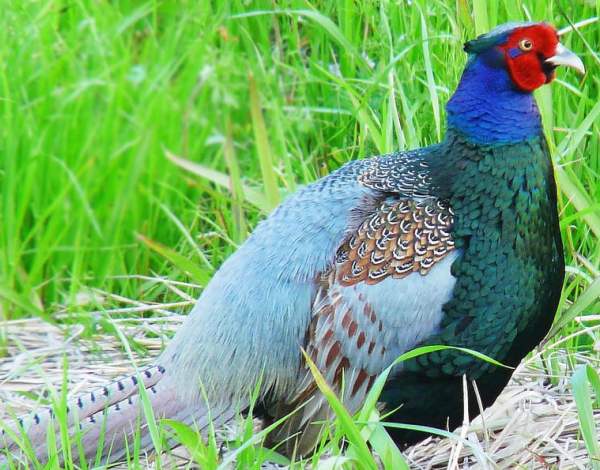

A small bright bird of the order of chickens has always attracted the attention of poultry enthusiasts for keeping for decorative purposes or for obtaining meat and eggs. And yet, pheasants remain quite an exotic poultry. Farms have long and successfully been engaged in this profitable business, but in private farmsteads, the cultivation of productive pheasants is much less common.
Representatives of pheasants are smaller than chickens, and most species are comparable in size to small egg breeds, but their dietary meat of excellent quality and with a unique taste is valued much higher than chicken meat, being considered a delicacy. Pheasant eggs are a piggy bank of minerals, proteins and vitamins with a significant advantage - low cholesterol levels.
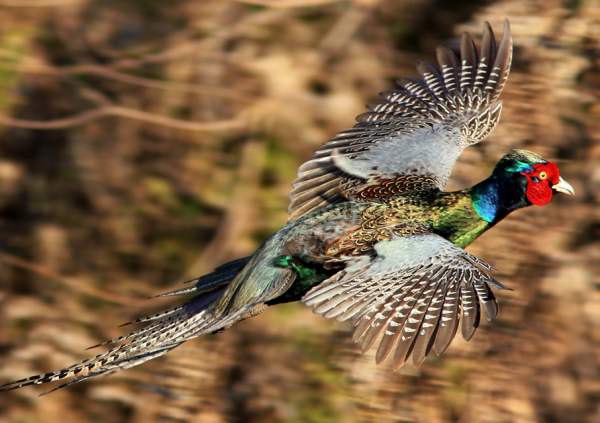

Many breeders take advantage of their passion for eating harmful insects, including Colorado beetles and their larvae, which other birds disdainfully bypass. A small group of beautiful birds is able to clear the beds of harmful insects in a few days, while obtaining valuable protein.
Variety of species and breeds of pheasants
The vast family of pheasants, in addition to the pheasants themselves, also includes turkeys, black grouses and partridges. The present pheasant includes two main types - ordinary (Caucasian) and green.
In addition, hobbyists in the household contain eared, collared pheasants and lofurs. A rare beauty that invariably attracts connoisseurs - the large pheasant Argus is kept less often, being a large bird, requires a special approach, but also deserves attention. In this review article, we will consider common, as well as some rare species and breeds of pheasants.
Real pheasants
Common pheasant
Outwardly, common pheasants, especially females, are very similar to chickens, but there are significant differences - a longer tail plumage, the pointed feathers of which taper and give the bird an elegant look, and the unfeathered red skin around the eyes is a kind of face mask.
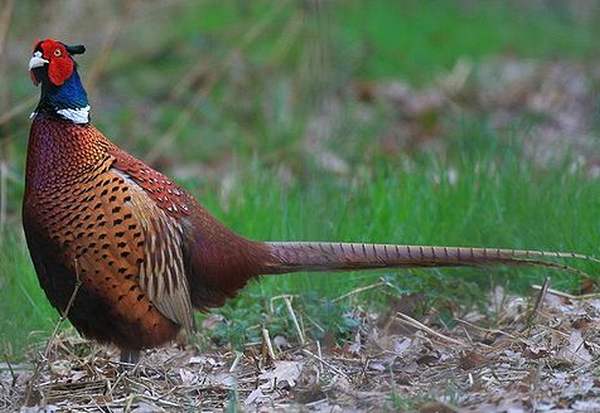

Males, like all pheasants, are brighter than females - their rich plumage is dotted with a variety of eye-catching shades - yellow, orange, purple, shining green. The male has spurs on his legs, the tail is long - up to 55 cm, while in chickens the tail plumage is much shorter - up to 30 cm. The length of males is up to 80 cm, weight is about 1.8-2.0 kg. Females are smaller - up to 60 cm and lighter - up to 1.5 kg.
In their natural environment, pheasants prefer to settle in areas with dense vegetation, near water bodies, near settlements, feeding on corn or wheat fields.


Males desperately defend their territory from encroachments, arranging deadly battles with rivals in the spring. The female lays from 8 to 15 olive eggs in a hole dug in the ground, and begins to hatch them selflessly. Active chickens appear in 3-4 weeks and, not having time to dry out, begin to run and feed, reaching the size of an adult bird in 4.5-5 months.
Features of the content: care and feeding
Farmers who decide to purchase pheasants for home breeding should remember that this bird requires special care in compliance with the basic rules of keeping.
Attention! Birds for captivity can be bought, caught on their own, or raised from an egg.
It is necessary to place pheasants in cages or aviaries, while the "houses" must meet the following requirements:
- be spacious, one adult must have at least 2 sq. m. space.
- be of sufficient height, from 1.5 to 2 m;
- when keeping pheasants indoors, it is advisable to equip their place of residence with artificial light sources;
- drinkers and feeders must be kept clean, otherwise the birds will suffer from parasitic diseases;
- for females to rush well, it is necessary to set aside a place for equipping nests and provide the birds with "material" for construction - corn stalks or reeds;
- individuals can be kept in pairs or 5 birds in one cage, 4 of which are females and 1 male (depending on whether the selected breed is polygamous or monogamous).
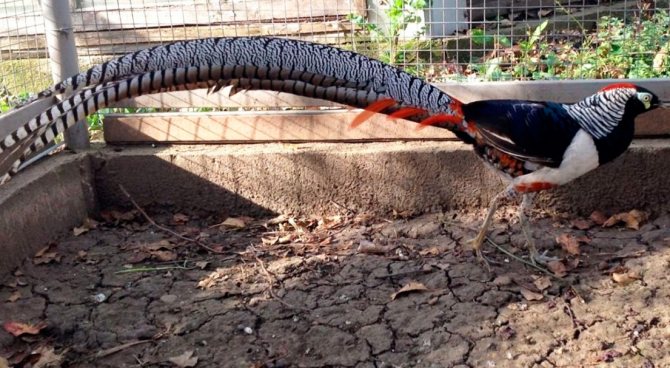

The pheasant's enclosure should be spacious.
It is important to remember that these individuals are shy and stress negatively affects their health. For this reason, you should not irritate them with harsh sounds, and the same people should be engaged in cleaning and feeding so that the birds get used to them.
Feeding captive pheasants involves significant financial costs. Their diet should contain:
- wheat;
- barley;
- corn;
- cake;
- fishmeal and fish oil;
- yeast;
- a piece of chalk;
- vitamin and mineral supplements.
The recommended amount of food per meal is 3-5 g per adult.

